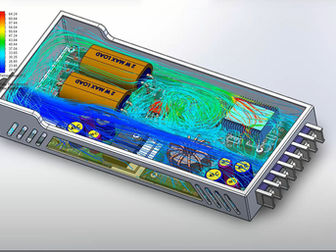In this article, we talk about some common manufacturing processes used in the creation of testing, scientific and analytical equipment used in life sciences, environmental analysis, material testing and others applications.
This article will be helpful for product managers, designers and other professionals who are tasked with developing such equipment.
Specialized equipment like spectrometers, analyzers, life sciences equipment, large machinery etc are not manufactured in high volumes like consumer products. Therefore, the manufacturing processes used in consumer products (like injection molding) are often not suitable for low volume production.
Outdesign Co is a product development company that designs and develops enclosures for a range of products and equipment. Get a Quote for your project.

Below are some of the commonly used low-volume manufacturing processes that are suitable for analytical, testing, scientific and other equipment:-
1. Thermoforming
Thermoforming involves heating a thermoplastic sheet until it becomes pliable, then forming it over a mold or tool, and finally cooling it to maintain its new shape. Depending on how the air pressure is applied to the sheet, thermoforming can be of 2 types - vacuum forming and pressure forming.
Thermoforming is widely used in industries such as packaging, automotive, aerospace, and consumer goods.
Due to the inexpensive molds, high quality surface finish and versatility in the shape and size of parts, thermoforming is a great choice for low-volume production of equipment enclosures that require plastic.
2. RIM (Reaction Injection Molding)
Reaction molding, also known as reaction injection molding (RIM) or resin transfer molding (RTM), is a manufacturing process used to create complex plastic parts using reactive liquid resins. It involves the mixing and injection of two or more liquid components that react chemically and solidify to form the desired part.
Reaction molding offers several advantages for creating enclosures, including the ability to produce large, complex parts with intricate geometries, excellent dimensional stability, and a wide range of material properties. It allows for the incorporation of inserts, reinforcements, or encapsulated components within the part. Reaction molding also enables the production of parts with high strength-to-weight ratios, chemical resistance, and durability. The process is particularly suitable for low to medium volume production runs, although it can also be used for prototyping and creating small batches.
3. Silicone Molding
Silicone molding, also known as resin casting or silicone casting, is a process that uses silicone as the molding material which makes the molds very inexpensive, and the resulting enclosure parts cost-effective.
It allows for the production of enclosures with complex shapes, undercuts, and thin sections. Additionally, silicone molding enables the creation of prototypes or small to medium production runs with relatively low tooling costs, high part quality and shorter lead times compared to traditional manufacturing methods like injection molding. The size of parts that can be created through silicone molding is limited.
4. Sheet Metal Fabrication
Enclosures made from sheet metal are the most common across a range of industries including analytical equipment, medical equipment, electrical enclosures and more.
Sheet metal fabrication provides durability, structural strength, and the ability to create enclosures with precise dimensions. Common techniques include laser cutting, CNC punching, bending, and welding.
Sheet metal enclosures require almost no upfront investment and are a cost-effective option for prototyping, low volume production as well as scaling up.
5. CNC Machining
CNC machining offers precise control, repeatability, and the ability to create complex shapes and features. It is well-suited for both prototyping and production runs of enclosures, providing high-quality results and the ability to work with various materials to meet specific design requirements. CNC machining is more commonly used to create various custom parts for the equipment, prototypes or molds for use in other processes.
6. Composite Fiber Layup
Fiber layup, or composite layup, is a manufacturing technique used to create parts using fiber-reinforced composites such as fiberglass or carbon fiber. This method involves layering fiber sheets or fabrics over a mold and impregnating them with a resin matrix to form a solid and strong structure.
The biggest advantage of the fiber layup process is the large sized panels that can be made, as compared to any other plastic manufacturing process mentioned here. Apart from size, composite parts are lightweight, strong, and durable with specific performance characteristics.












Comments